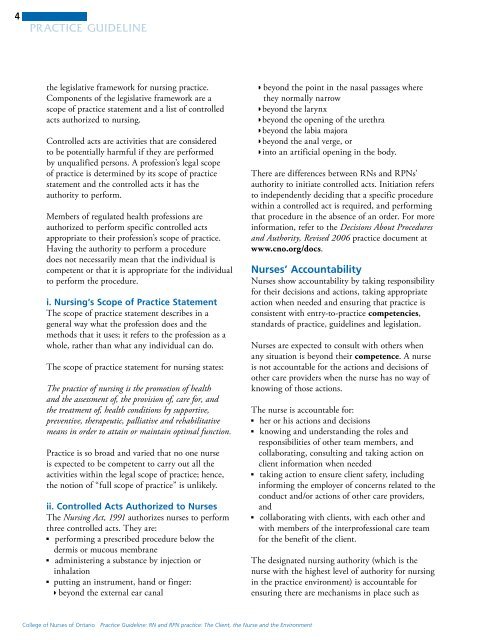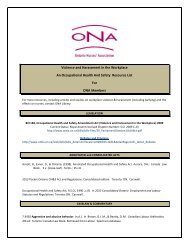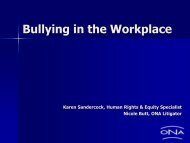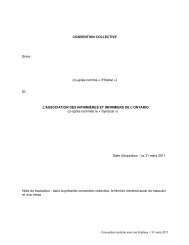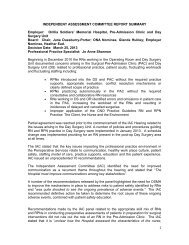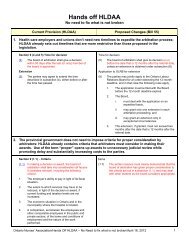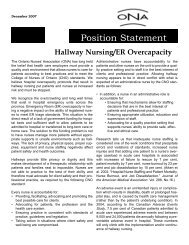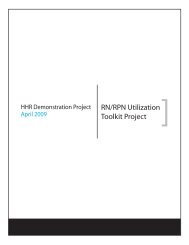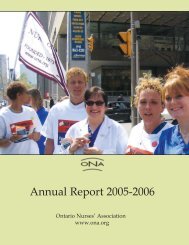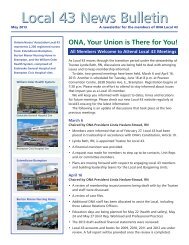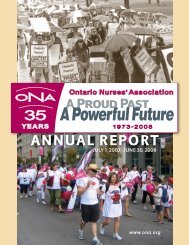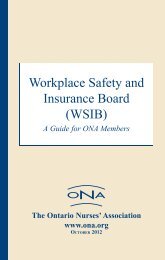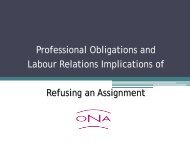RN and RPN Environment Professional Practice Teleconnect
RN and RPN Environment Professional Practice Teleconnect
RN and RPN Environment Professional Practice Teleconnect
You also want an ePaper? Increase the reach of your titles
YUMPU automatically turns print PDFs into web optimized ePapers that Google loves.
4<br />
<strong>Practice</strong> Guideline<br />
the legislative framework for nursing practice.<br />
Components of the legislative framework are a<br />
scope of practice statement <strong>and</strong> a list of controlled<br />
acts authorized to nursing.<br />
Controlled acts are activities that are considered<br />
to be potentially harmful if they are performed<br />
by unqualified persons. A profession’s legal scope<br />
of practice is determined by its scope of practice<br />
statement <strong>and</strong> the controlled acts it has the<br />
authority to perform.<br />
Members of regulated health professions are<br />
authorized to perform specific controlled acts<br />
appropriate to their profession’s scope of practice.<br />
Having the authority to perform a procedure<br />
does not necessarily mean that the individual is<br />
competent or that it is appropriate for the individual<br />
to perform the procedure.<br />
i. Nursing’s Scope of <strong>Practice</strong> Statement<br />
The scope of practice statement describes in a<br />
general way what the profession does <strong>and</strong> the<br />
methods that it uses; it refers to the profession as a<br />
whole, rather than what any individual can do.<br />
The scope of practice statement for nursing states:<br />
The practice of nursing is the promotion of health<br />
<strong>and</strong> the assessment of, the provision of, care for, <strong>and</strong><br />
the treatment of, health conditions by supportive,<br />
preventive, therapeutic, palliative <strong>and</strong> rehabilitative<br />
means in order to attain or maintain optimal function.<br />
<strong>Practice</strong> is so broad <strong>and</strong> varied that no one nurse<br />
is expected to be competent to carry out all the<br />
activities within the legal scope of practice; hence,<br />
the notion of “full scope of practice” is unlikely.<br />
ii. Controlled Acts Authorized to Nurses<br />
The Nursing Act, 1991 authorizes nurses to perform<br />
three controlled acts. They are:<br />
■<br />
performing a prescribed procedure below the<br />
■<br />
dermis or mucous membrane<br />
administering a substance by injection or<br />
inhalation<br />
■<br />
putting an instrument, h<strong>and</strong> or finger:<br />
◗ beyond the external ear canal<br />
◗ beyond the point in the nasal passages where<br />
they normally narrow<br />
◗ beyond the larynx<br />
◗ beyond the opening of the urethra<br />
◗ beyond the labia majora<br />
◗ beyond the anal verge, or<br />
◗ into an artificial opening in the body.<br />
There are differences between <strong>RN</strong>s <strong>and</strong> <strong>RPN</strong>s’<br />
authority to initiate controlled acts. Initiation refers<br />
to independently deciding that a specific procedure<br />
within a controlled act is required, <strong>and</strong> performing<br />
that procedure in the absence of an order. For more<br />
information, refer to the Decisions About Procedures<br />
<strong>and</strong> Authority, Revised 2006 practice document at<br />
www.cno.org/docs.<br />
Nurses’ Accountability<br />
Nurses show accountability by taking responsibility<br />
for their decisions <strong>and</strong> actions, taking appropriate<br />
action when needed <strong>and</strong> ensuring that practice is<br />
consistent with entry-to-practice competencies,<br />
st<strong>and</strong>ards of practice, guidelines <strong>and</strong> legislation.<br />
Nurses are expected to consult with others when<br />
any situation is beyond their competence. A nurse<br />
is not accountable for the actions <strong>and</strong> decisions of<br />
other care providers when the nurse has no way of<br />
knowing of those actions.<br />
The nurse is accountable for:<br />
■<br />
her or his actions <strong>and</strong> decisions<br />
■<br />
knowing <strong>and</strong> underst<strong>and</strong>ing the roles <strong>and</strong><br />
responsibilities of other team members, <strong>and</strong><br />
collaborating, consulting <strong>and</strong> taking action on<br />
client information when needed<br />
■<br />
taking action to ensure client safety, including<br />
informing the employer of concerns related to the<br />
conduct <strong>and</strong>/or actions of other care providers,<br />
<strong>and</strong><br />
■<br />
collaborating with clients, with each other <strong>and</strong><br />
with members of the interprofessional care team<br />
for the benefit of the client.<br />
The designated nursing authority (which is the<br />
nurse with the highest level of authority for nursing<br />
in the practice environment) is accountable for<br />
ensuring there are mechanisms in place such as<br />
College of Nurses of Ontario <strong>Practice</strong> Guideline: <strong>RN</strong> <strong>and</strong> <strong>RPN</strong> practice: The Client, the Nurse <strong>and</strong> the <strong>Environment</strong>


